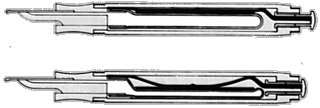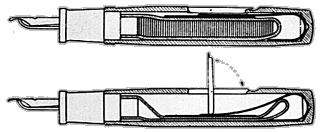Penexchange
- Home
- The "Cavalier of the Rose"
- Traveler's inkwell
- Fountain Pens for Use with Carbon paper
- Classifying Overlays
- The Toledo
- Why Piston Fillers !?
- Self-filling Pen
- The first Fountain Pens
- Many Brand Names - one Manufacturer
- Original Pelikan
- TULA-Silver-Overlays
- III. Series
- Pneumatik Fountain Pens
- How much would Grandmothers Fountain Pen be worth ?
- The Rappen-Fountain pen
- 400-400N-400NN
- IBIS 130E
Self-Filling Pens

"Self-Filling Pens"
After the safety fountain pen had solved many of the initial problems of the first fountain pens, the disadvantages of such pens very soon became clear (see "The first fountain pens"). In particular, filling the pen with ink with the aid of a pipette was understandably awkward. The obvious move was to make the pipette an integral part of the pen, so to speak. W. A. Sheaffer took up this idea and around 1908 designed a pen whose shaft enclosed a rubber sac. When this sac was squeezed together, the air was forced out; subsequently releasing the sac caused ink to be sucked in. This principle, the "self-filling" technique, featured in many variations and dominated the fountain pen market over the next 15 years. The main difference between these variations lay in the way the sac was squeezed together.

The principle of the push-button filler
The two main systems were the "push-button fillers" and the "lever fillers". The push-button variation incorporated a leaf spring inside the shaft which was bent by operating a push-button on the end of the pen; a narrow plate fitted to the middle of the spring squeezed the sac together. The lever filler, however, employed a different concept: a longitudinal slot was milled in the shaft in order to accommodate a movable lever. When the lever was folded out, the sac was squeezed together, like in the push-button version, by a small plate attached to ,the lever via a pivot. s

The principle of the lever filler
Other manufacturers took an easier route and simply milled a slot in the shaft. To squeeze the sac together, all that was needed was to press a coin into the slot. The American company Conklin expanded on this idea and incorporated a semicircular piece of metal in this slot, i.e. a sort of integral coin. By means of a pivoted ring, this "crescent", as Conklin called it, could be secured against being accidentally operated. However, this design was a little clumsy, which meant that this technically very efficient pen did not achieve the hoped-for success.
The fixed nib was one advantage of the sac-type fountain pen. This was because the danger of damaging the nib was much less than with the safety fountain pen. The cap was always screwed on and not slipped over, as was the case with the eye-dropper fountain pen. Therefore, the only problem was that of the cap cracking if it was slipped over the rear end of the pen rather too forcefully.
The Waterman 52V lever filler, c. 1920/25
But there was still, room for real improvement in the sac-type fountain pen as well. One major complaint was the - in comparison to its predecessors - really quite measly ink capacity because the sac and the mechanism occupied too much space inside the shaft. Another problem was that lever fillers tended to snap because the slot weakened the shaft. The rubber sacs used were also not terribly durable. If the sac was not replaced in good time, before it became brittle, then the pen started to leak.
Despite all these problems, this filling system has remained in use to this day. For example, the Parker company still uses sacs in its pens, albeit certainly made from a more durable material.
Martin Lehmann